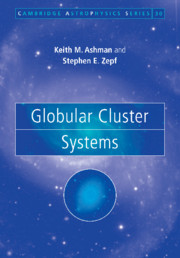Book contents
- Frontmatter
- Contents
- Preface
- 1 Introduction
- 2 Properties of globular clusters
- 3 The Galactic globular cluster system
- 4 Globular cluster systems in nearby galaxies
- 5 Properties of extragalactic globular cluster systems
- 6 Globular clusters and galaxy formation
- 7 The formation of globular clusters
- 8 Future prospects
- Appendix
- References
- Subject index
- Object index
3 - The Galactic globular cluster system
Published online by Cambridge University Press: 21 September 2009
- Frontmatter
- Contents
- Preface
- 1 Introduction
- 2 Properties of globular clusters
- 3 The Galactic globular cluster system
- 4 Globular cluster systems in nearby galaxies
- 5 Properties of extragalactic globular cluster systems
- 6 Globular clusters and galaxy formation
- 7 The formation of globular clusters
- 8 Future prospects
- Appendix
- References
- Subject index
- Object index
Summary
The globular cluster system of the Milky Way consists of over 150 known members. It is likely that not all the clusters have been detected, primarily because of obscuration by the Galactic bulge. The best estimate for the total population is around 180 objects. The system is centrally concentrated, with roughly half of the globular clusters residing within about 5 kpc of the Galactic center. However, the most remote clusters extend to beyond 100 kpc from the center of the Galaxy. The system is more usefully considered as two or more distinct subsystems. The majority of globular clusters form a roughly spherical, metal-poor, halo distribution. Recent evidence suggests that this halo population may itself be a composite system. A smaller number of globular clusters are relatively metal-rich and have the spatial and kinematic characteristics of a thick disk population. It has also been suggested that these metal-rich clusters can more properly be regarded as belonging to the bulge population of the Milky Way.
In this chapter, we examine the range of globular cluster properties, correlations between these properties, and how the characteristics of globular clusters vary with position within the Milky Way. We describe the evidence that has led to the separation of Milky Way globular clusters into distinct subsystems. The dynamical evolution of the Galactic globular cluster system and constraints on the properties of the initial Milky Way globular cluster system are also discussed. Finally, we consider the important question of what the Milky Way globular cluster system reveals about the formation and evolution of the Galaxy.
- Type
- Chapter
- Information
- Globular Cluster Systems , pp. 31 - 56Publisher: Cambridge University PressPrint publication year: 1998

